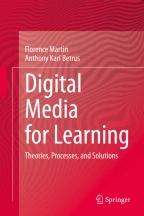
In this chapter, we provide an overview of elements that make up digital media/multimedia, along with the common tools used to create them and the description of digital media solutions. We also include the competencies expected of someone developing multimedia. We then discuss best practices for developing digital media, including the use of development models. We conclude with a summary of benefits and challenges of integrating digital media for learning.
This is a preview of subscription content, log in via an institution to check access.
eBook EUR 117.69 Price includes VAT (France)
Softcover Book EUR 147.69 Price includes VAT (France)
Hardcover Book EUR 147.69 Price includes VAT (France)
Tax calculation will be finalised at checkout
Purchases are for personal use only
By Krista Collins, Higher Education Learning and Development Specialist
In higher education, a constant training need exists to provide some type of orientation to every new employee hired by the university including either printed or digital access to key information. This includes access to trainings key to job performance, legal and compliance training, health and safety awareness, and all policies and procedures deemed key by the university’s Board of Trustees. In conducting a Program Analysis, our Learning and Development Organization recognized a need to transform a two-day face to face orientation to a 120-day onboarding course using multimedia to create an engaging learning experience for a broad target audience. This experience would be delivered in an online format using a Learning Management System and contain six distinct learning modules with corresponding objectives covering all of the information new employees would need to be fully onboarded into university culture.
To begin the Design process, our team established best practices using the basic elements of multimedia described by Neo and Neo (2001) to create a multisensory experience and also circumvent the challenges of developing a course for such a broad target audience. Texts would use no less than 12-point Arial font. Images and graphics used in the course would be visual representations of content, and images specific to the university would be captured screenshots for illustration. Voice narration would be provided by a single narrator using a male neutral tone. Any videos used would be provided by our Subject Matter Experts and be relevant to the university. Lastly, any animations would be kept to a minimum to eliminate distraction or detract from the overall learning experience.
Designing this online course also meant that we needed to keep the overall learning experience of every new employee to the university as our main priority. This included listing the learning objectives at the beginning of each module using clear and concise text that was simple and to the point. We even included basic navigation explanations keeping in mind that computer efficacy skills would mirror the broadness of our target audience. Learning activities would be designed with user-friendly interface including interactive activities that would provide multiple opportunities to apply new knowledge such as graded knowledge checks built into the eLessons with immediate feedback and digital checklists for learners to identify areas of improvement at the end of each module.
In the Development process, we kept Mayer’s (2003) contiguity principle in mind remembering that multimedia learning via words and pictures is a powerful tool in online learning. Any of the images that we chose for the modules and eLessons were aligned with texts. We even made sure to use the same color scheme throughout the online course by choosing university approved color combinations that would lend to the onboarding experience. In fact, visual elements followed Mayer’s (2003) multimedia coherence principle with all texts, pictures, audio, and video enhancing the transfer of university knowledge to the new employees. This included visual cues built into modules and eLessons that used bold text or information markers to highlight key concepts of the onboarding course and closed captioning notifications available for all videos to increase accessibility. Our biggest accomplishment using multimedia was the incorporation of avatars using images of people in different attire to represent the diversity in our target audience and support Mayer’s (2003) personalization principle.
The final deliverable was an online course that used multimedia to reach a broad target audience and fully onboard all new employees to the university. The use of eLessons, videos, interactive activities, knowledge checks, and digital checklists created an immersive experience for each new employee. The online course used self-pacing and was easily accessible to all new employees by accepting a simple course invitation in their standard, university email account. And because university life is one of constant and fluid change in policies and procedures, our team will continue to be able to Evaluate the relevance of course content and make updates easily since multimedia enabled us to implement our course online. Overall, using multimedia was the best choice for our new onboarding course and helped us to accomplish our goal to move from a face to face environment to a learning environment representative of a Twenty-first Century workforce.
© 2019 Springer Nature Switzerland AG